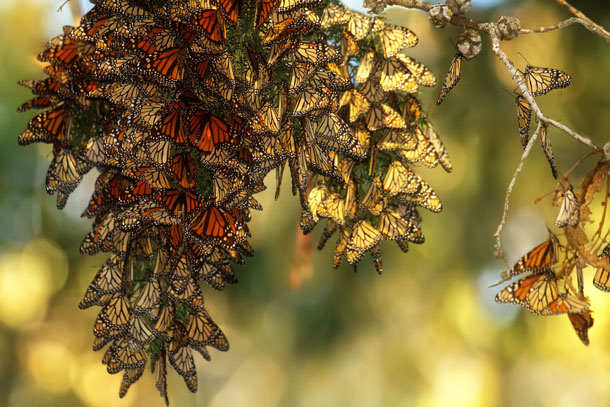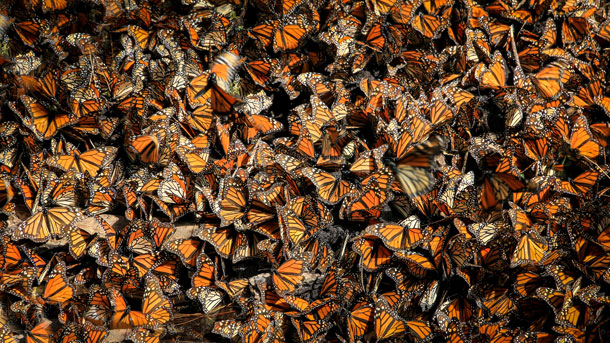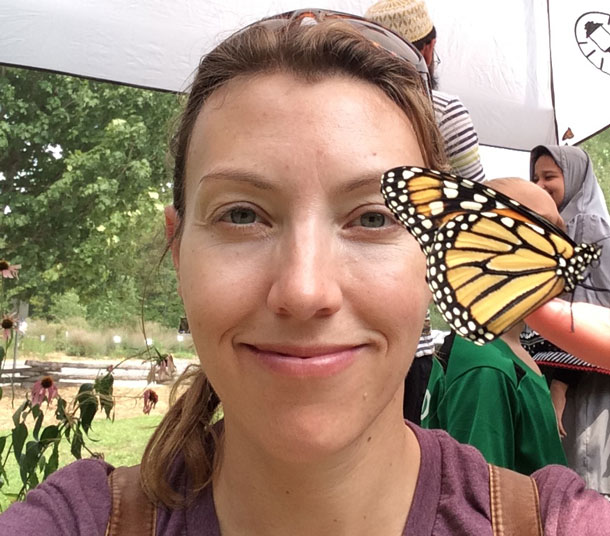Monarch Butterflies Rebound
Air Date: Week of February 15, 2019

Monarch butterflies from west of the Rocky Mountains cluster amongst trees in Pismo Beach, California. (Photo: Sandy Chuck Harris, Flickr, CC BY-NC 2.0)
Biologists are celebrating a promising year for eastern monarch butterflies, which overwinter in Mexico and whose population grew 144 percent from last year. But it’s a different story for the western monarch population, which spends the winter in California. Down to just 30,000 individuals, they’re on the edge of extinction. Tierra Curry, a Senior Scientist at the Center for Biological Diversity, talked to Bobby Bascomb about the monarch butterflies’ remarkable annual migration and what can be done to boost their numbers.
Transcript
BASCOMB: Each year monarch butterflies travel from as far away as Canada to spend the winter in Mexico. The world’s entire population of Eastern Monarchs cluster together on just a few acres of a forest in the Sierra Madre mountains. That dense congregation makes the species vulnerable to predation and extreme weather. But it also makes it easy for biologists to count them and get an estimate of their numbers. And this year there was good news! There were more than twice as many Eastern Monarchs in 2018 compared with the previous year. But the news wasn’t good for Western Monarchs, which spend their winters in California. Here to explain is Tierra Curry, a senior scientist from the Center for Biological Diversity. She joins us from Portland, Oregon. Welcome back to Living on Earth!
CURRY: Thanks so much. It's great to be here.
BASCOMB: First, can you tell me a little bit about the incredible generational migration that monarchs undertake each year?
CURRY: Absolutely. Monarchs are amazing, and one of the most amazing things about them is they do this multi-generational migration. So we'll start at the end of summer. At the end of summer, monarch butterflies in the northern United States and southern Canada, wake up and go, “Oh, my gosh, I need to go to Mexico.” And they've never been to Mexico, and somehow, this generation, which is the great, great, great grandchildren of the monarchs that were in Mexico fly all the way back to the mountains of central Mexico to overwinter. So that's the super generation of monarchs. And they live for nine months, they overwinter, and then in the spring, they fly north from the sanctuaries in Mexico to Texas and the southern United States. They lay eggs and die. When those eggs become caterpillars that become butterflies, they only live a couple weeks, and they fly north again. And so there's three or four successive generations over summer till you get back to the super generation that overwinters.

Monarch butterflies cover oyamel fir trees while overwintering in Michoacan, Mexico. They undertake an incredible migration of 3,000 miles or more to protect themselves from winter in the North. (Photo: Alex Guillaume on Unsplash)
BASCOMB: And when that third or fourth generation of Eastern monarchs, they finally make it to Mexico, they have a very specific area where they can spend the winter. Can you tell me about that please?
CURRY: They do. They go to 12 mountain tops between the city of Morelia and Mexico City. And it's above 10,000 feet, it’s oyamel fir forest and they cluster super densely on the trees. And they're supposed to chill out while they're there, they're supposed to save their energy and fat reserves so that they can fly north again in the spring. But, if it's unseasonably warm or if tourists disturb them, then they wake up and fly around too much and they might burn off their lipid supplies and they would have a decreased success of making it north again. So that's why they go there. It's not too hot, not too cold, it's the perfect place for them to overwinter.
BASCOMB: Like Goldilocks, it's just right.
CURRY: Right, exactly.
BASCOMB: So those are the eastern monarchs that spend their winters in Mexico, and how are they doing this year?
CURRY: They're doing great this year. It's such good news, there are six hectares of monarch butterflies in Mexico this winter. And that's up 140% from last year. And most importantly, that's just above the threshold that scientists say they need to be at to not be in danger of quasi-extinction or migratory collapse. So for this one good year, due to great weather, they’re right above the danger zone.
BASCOMB: So that's the eastern monarchs. But there are also a population of western monarchs, what's the difference between them?
CURRY: So genetically, they’re similar, and there is some interbreeding between them. Roughly, all the monarchs east of the Rocky Mountains go to Mexico for the winter; the monarchs west of the Rocky Mountains overwinter on the coast of California. And unfortunately, they had a terrible year. There are only 30,000 total Western monarchs this winter. And kind of the opposite of what happened with the eastern population --30,000 is at the threshold to be not recoverable. It's the quasi-extinction threshold identified in population modeling.
BASCOMB: And what were their populations like, say, 20, 30, 40 years ago, as compared to today?
CURRY: So historically, there would have been millions of Western monarchs. The scientists started counting them in 1997, the Xerces society started counting them, and in 1997, there were 1.2 million. And so this count is 30,000.
BASCOMB: Wow. What kind of protections are there in place for monarchs right now?
CURRY: None. Zero. I got an email this morning from somebody who has like a wetland with a bunch of milkweed that's going to be developed. And they wanted to know if having monarchs there could protect it, and the answer is no. But back in 2014, the Center for Biological Diversity and our allies petitioned for Endangered Species Act protection for monarchs and that decision has to be issued by the US Fish and Wildlife Service by the end of June this year.

Monarch butterflies' main food source is milkweed. (Photo: Ryan Carpenter on Unsplash)
BASCOMB: And how would it change their fate if they do get that protection?
CURRY: It would help them in so many ways; one, their habitat would be protected. So it wouldn’t, you couldn’t cut down their overwintering trees. Like in California, their overwintering trees can still be cut down for development, and that would end. And then it would also lead to a recovery plan that would outline all the steps that are needed to boost the population and keep it above the six hectares of covered forest habitat.
BASCOMB: Talk to me a bit about monarchs and the role that they play in the ecosystem. Why are they important ecologically?
CURRY: They're important ecologically because, well, when there were billions of them, they would have played a very big role in the food web. And they still provide food for other species as eggs, as caterpillars, and as adults. We just have to have enough monarchs for all the animals that want to eat them to be able to eat them, because predation is natural. So that's why there has to be millions and billions of monarchs.
BASCOMB: Now, what about the cultural significance of monarchs, especially in Mexico, where they just descend on this one small area, what do the people there think of them?
CURRY: In Mexican folklore, the monarchs represent the departed souls of loved ones, because they usually get back to Mexico in time for the Day of the Dead celebrations, like, that's when they arrive. And so they symbolize the departed souls of loved ones. And it's interesting, because in Mexico, monarchs represent fall and winter. But in the United States and Canada, monarchs are a symbol of summer and playing outside and seeing them in your garden.

Tierra Curry, Senior Scientist at the Center for Biological Diversity. (Photo: Courtesy of Tierra Curry)
BASCOMB: Yeah, yeah, exactly. I mean, I remember as a kid, a friend’s mom used to bring them to school in a big pickle jar, you know, and you’d get to watch them change and go through their metamorphosis. And this past summer, I actually raised some with my own daughter.
CURRY: Oh, that's great.
BASCOMB: Yeah, it was really, really fun, actually. But is that actually a useful thing for people to do to raise them inside? Does it help them at all to, you know, not get picked off by a bird? Or is it just for our own benefit to have this neat thing?
CURRY: It's really for our own benefit. So many people have had that same experience, and raised monarchs in classrooms and in their home. And I think that's why people love them so much, and why people are willing to plant milkweed now and to eat organic corn and soy products to help them. But we're not going to save the monarchs by bringing them inside. And then there's this parasite called OE that can be really harmful to monarchs. It can cause them not to develop properly, to be underweight, or even to die, they might not make it through metamorphosis. And so if people bring in too many monarchs, and they don't between seasons bleach out their cages, then they can cause the parasite to do in the caterpillars that they're trying to raise. And especially what people shouldn't do is go to wild areas, and get those caterpillars and take them in their house. Like if you have the milkweed in your yard, and, you know a bird’s gonna eat the caterpillar, save its life. But don't go kidnap them from the wild.
BASCOMB: So what should a listener do if you're concerned about monarchs, and you have this, you know, relationship with them. What can we do?
CURRY: Plant milkweed, but milkweed that's native to the area where you live. There's, tropical milkweed is bad. It's pretty and it's easy to grow, but it's not native to the United States. And it doesn't die back in the fall, especially in warm areas. And so it just confuses the monarchs. So make sure that you plant native milkweed. And if it's still up at the end of fall, cut it down. One of the biggest threats to the monarchs is pesticides and insecticides. And so by growing or buying organic corn and soy products, in particular, because all of the habitat that has been turned over to genetically modified corn and soy that is treated heavily with herbicide has wiped out milkweed. So by buying organic corn and soy products, it supports the organic industry, which doesn't use those pesticides that hurt monarchs and other pollinators. And the US Fish and Wildlife Service is deciding right now whether or not to protect monarchs under the Endangered Species Act so people can write the US Fish and Wildlife Service and say, Please protect the monarchs as an endangered species so that they'll have a recovery plan and funding so that our kids and our grandkids will get to see the monarch butterflies.
BASCOMB: Yeah, raise them in those pickle jars, maybe.
CURRY: Yeah [LAUGHS]
BASCOMB: Tierra Curry is a senior scientist with the Center for Biological Diversity. Tierra, thanks for talking.
CURRY: Thanks for talking about monarchs.
Links
The Center for Biological Diversity's Petition to Protect the Monarch Butterfly
Center for Biological Diversity Press Release: Annual Monarch Count Shows Butterfly Still Threatened
Center for Biological Diversity: Saving the Monarch Butterfly
Living on Earth wants to hear from you!
Living on Earth
62 Calef Highway, Suite 212
Lee, NH 03861
Telephone: 617-287-4121
E-mail: comments@loe.org
Newsletter [Click here]
Donate to Living on Earth!
Living on Earth is an independent media program and relies entirely on contributions from listeners and institutions supporting public service. Please donate now to preserve an independent environmental voice.
NewsletterLiving on Earth offers a weekly delivery of the show's rundown to your mailbox. Sign up for our newsletter today!
 Sailors For The Sea: Be the change you want to sea.
Sailors For The Sea: Be the change you want to sea.
 The Grantham Foundation for the Protection of the Environment: Committed to protecting and improving the health of the global environment.
The Grantham Foundation for the Protection of the Environment: Committed to protecting and improving the health of the global environment.
 Contribute to Living on Earth and receive, as our gift to you, an archival print of one of Mark Seth Lender's extraordinary wildlife photographs. Follow the link to see Mark's current collection of photographs.
Contribute to Living on Earth and receive, as our gift to you, an archival print of one of Mark Seth Lender's extraordinary wildlife photographs. Follow the link to see Mark's current collection of photographs.
 Buy a signed copy of Mark Seth Lender's book Smeagull the Seagull & support Living on Earth
Buy a signed copy of Mark Seth Lender's book Smeagull the Seagull & support Living on Earth

